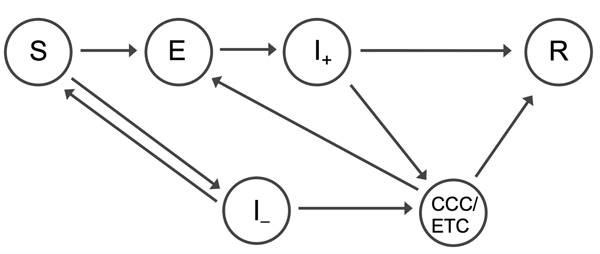Volume 21, Number 3—March 2015
Research
Evaluation of the Benefits and Risks of Introducing Ebola Community Care Centers, Sierra Leone
Figure 1

Figure 1. Structure of transmission model used to evaluate the benefits and risks of introducing CCCs into Western Area, Sierra Leone. Persons start off being susceptible to infection (S). Upon infection with Ebola virus, they enter an incubation period (E), and at symptom onset, they become infectious in the community (I+). After this point, infected persons seek health care in CCCs or ETCs; if centers are full, the infectious persons remain in the community until the infection is resolved (R) (i.e., the patients have recovered from the disease or are dead and buried). Patients admitted to ETCs and CCCs also move into the resolved compartment (R). We also assume that Ebola virus–susceptible persons could also become infected with other febrile diseases that have Ebola virus disease–like symptoms (I–). These Ebola virus–negative patients also seek health care; if centers are full, the patients return to the susceptible compartment (S) as symptoms wane. We assume the latent period is 9.4 days, the average time from symptom onset to CCC attendance is 3 days, and the average interval from symptom onset to ETC attendance is 4.6 days. CCCs, Ebola community care centers; ETCs, Ebola treatment centers.